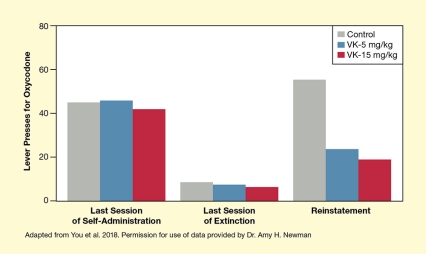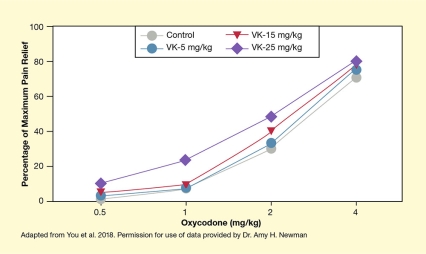This study reported:
- The dopamine D3 receptor antagonist VK4-116 reduced oxycodone self-administration in rats, as well as drug-seeking behaviors after oxycodone reinstatement following withdrawal.
- VK4-116 did not interfere with oxycodone’s pain-relieving effects.
Medications to prevent and treat opioid use disorder (OUD) as well as to prevent relapse are urgently needed. In animal studies, dopamine D3 receptors have emerged as potential therapeutic targets for reducing addiction-related behaviors. Dr. Zhi-Bing You and colleagues from NIDA’s Intramural Research Program (IRP) and Johns Hopkins University now show that a novel agent called VK4-116, which blocks dopamine D3 receptor activity, can reduce a variety of addiction-like behaviors related to oxycodone administration in rats. “We are very excited that our highly selective D3 receptor antagonist, VK4-116, was effective in a multitude of behavioral models associated with OUD, providing preclinical data to support further development toward the clinic,” says NIDA IRP’s Dr. Amy Hauck Newman, the study’s senior investigator.
Dr. You and colleagues trained rats to self-administer oxycodone by pressing a lever. The investigators then conducted several experiments modeling different aspects of addiction-like behaviors. In these tests, VK4-116 counteracted oxycodone’s effects. For example:
- Pretreatment with VK4-116 reduced the number of oxycodone infusions the rats pressed the lever for, and this effect lasted for several days after treatment (see Figure 1A).
- Once the rats self-administered oxycodone, VK4-116 pretreatment decreased lever responses for oxycodone (see Figure 1B).
- Pretreatment with VK4-116 did not affect sucrose self-administration (see Figure 1C).
- VK4-116–treated rats that were given a single injection of oxycodone to trigger reinstatement of drug use after extinction were less likely to seek out more drug (see Figure 2).
Additional experiments found that VK4-116 may also be useful in ameliorating naloxone-precipitated withdrawal symptoms in oxycodone-dependent animals. Naloxone, the drug used to counteract opioid overdose, will induce severe withdrawal symptoms in humans who are dependent on opioids. Oxycodone-dependent rats too will experience withdrawal when given naloxone and will avoid locations where they received that medication. This conditioned place aversion is thought to represent the aversive aspects of withdrawal. Dr. You and colleagues found that VK4-116 reduced the naloxone-triggered conditioned place aversion, suggesting that the compound may dampen withdrawal symptoms.
Oxycodone is a highly effective pain reliever, so the investigators also tested if VK4-116 interfered with analgesia. They found that pretreatment with VK4-116 did not reduce oxycodone’s analgesic effect and even enhanced it at the highest VK4-116 dose tested (see Figure 3).
Although all of these preclinical findings are promising, further evaluation will be needed to reveal their translational potential. Nevertheless, the research team hopes that D3 receptor antagonists may one day help prevent addiction in people prescribed opioid medications or that they could be combined with behavioral therapies to mitigate withdrawal and reduce relapse risk in those being treated for OUD. “Demonstrating that VK4-116 is safe for human use and that our preclinical models actually predict treatment potential in OUD patients is critical,” says Dr. Newman. “In the meantime, our lab will continue to develop the tools needed to further elucidate the role of the D3 receptor in OUD and pain management.”
This study was supported by NIDA-IRP grant DA000424.
- Caption and text description of Figure 1
-
Caption - (A) Pretreatment of rats with VK4-116 during the first five oxycodone self-administration sessions reduced drug self-administration, measured as the number of oxycodone infusions the animals triggered. Oxycodone self-administration slowly increased after VK4-116 pretreatment was stopped. (B) When oxycodone was withheld from self-administering rats, those that were pretreated with VK4-116 had significantly fewer lever responses to obtain oxycodone than control animals, indicating reduced oxycodone-seeking during extinction. (C) The effects of VK4-116 were specific to oxycodone; sucrose self-administration did not differ between animals treated with VK4-116 and control animals.
Text Description - The graphs illustrate the effects of pretreatment with different doses of VK4-116 on oxycodone self-administration in rats. Panel (A) at the top shows self-administered oxycodone doses during 11 treatment sessions. The horizontal x-axis shows the treatment sessions from 1 to 11, with a break between sessions 5 and 6, indicating the end of VK4-116 treatment. The vertical y-axis shows self-administered oxycodone doses on a scale from 0 to 40. A horizontal black line above the curves for session 1 to 5 represents VK4-116 pretreatment. The gray curve with round symbols representing control animals shows self-administration of about 13 doses of oxycodone in session 1; about 15 doses in session 2; about 17 doses in session 3; about 18 doses in session 4; about 19 doses in sessions 5, 6, and 7; about 18 doses in session 8; about 21 doses in session 9 and 10; and about 20 doses in session 11. The blue curve with round symbols for animals pretreated with 5 mg/kg VK4-116 shows self-administration of about 8 oxycodone doses in session 1; about 9 doses in session 2; about 11 doses in session 3; about 10 doses in sessions 4, 5, and 6; about 11 doses in session 7, about 12 doses in session 8; about 13 doses in session 9; about 14 doses in session 10, and about 17 doses in session 11. The red curve with triangles for animals pretreated with 15 mg/kg VK4-116 shows self-administration of about 4 oxycodone doses in sessions 1, 2, and 3; about 5 doses in sessions 4 and 5; about 8 doses in session 6; about 9 doses in sessions 7 and 8; about 11 doses in session 9; about 12 doses in session 10, and about 14 doses in session 11.
The bar chart in panel (B) at the bottom left shows lever responses during extinction in rats with or without pretreatment with VK4-116. The horizontal x-axis shows the treatment; the vertical y-axis shows the number of lever responses during extinction on a scale from 0 to 150. Control animals (gray bar on the left) had about 105 lever responses; animals pretreated with 5 mg/kg VK4-116 (blue bar in the middle) had about 50 lever responses; and animals pretreated with 15 mg/kg VK4-116 (red bar on the right) had about 30 lever responses.
The bar chart in panel (C) at the bottom right shows self-administered sucrose doses in rats with and without pretreatment with VK4-116. The horizontal x-axis shows the treatment and the vertical y-axis shows the number of self-administered sucrose doses on a scale from 0 to 150. Control animals (gray bar on the left), animals pretreated with 15 mg/kg VK4-116 (red bar in the middle), and animals pretreated with 25 mg/kg VK4-116 (purple bar on the right) all self-administered 100 sucrose doses.
- Caption and text description of Figure 2
-
Caption - Rats that had been trained to self-administer oxycodone, followed by extinction, then received a single oxycodone injection to trigger reinstatement. While oxycodone self-administration was similar for all three groups during the last self-administration and extinctions sessions, pretreatment with VK4-116 reduced reinstatement of oxycodone compared with control animals.
Text Description - The bar chart illustrates that pretreatment with VK4-116 reduces oxycodone self-administration during reinstatement after extinction. The horizontal x-axis represents the animals during the last session of self-administration (left set of bars), during the last session of extinction (middle set of bars), and during reinstatement (right set of bars). Control animals are represented by gray bars, animals pretreated with 5 mg/kg VK4-116 by blue bars, and animals pretreated with 15 mg/kg VK4-116 by red bars. The vertical y-axis shows the number of lever presses for oxycodone on a scale from 0 to 80. During the last session of self-administration, control animals had about 45 lever presses, those pretreated with 5 mg/kg VK4-116 had about 47 lever presses, and those pretreated with 15 mg/kg VK4-116 had about 42 lever presses. During the last session of extinction, control animals had about 9 lever presses, those pretreated with 5 mg/kg VK4-116 had about 8 lever presses, and those pretreated with 15 mg/kg VK4-116 had about 7 lever presses. During reinstatement, control animals had about 55 lever presses, those pretreated with 5 mg/kg VK4-116 had about 25 lever presses, and those pretreated with 15 mg/kg VK4-116 had about 20 lever presses.
- Caption and text description of Figure 3
-
Caption - The researchers injected rats with oxycodone with or without pretreatment with three different doses of VK4-116 and then assessed pain suppression achieved with three different oxycodone doses. They reported oxycodone’s pain suppressing effect as the percentage of maximum pain relief (measured as the maximum time interval [determined to avoid injury to the animals] animals kept their foot on a hot plate before becoming uncomfortable). In animals pretreated with the two lower VK4-116 doses, oxycodone showed the same analgesic effect as in untreated animals. However, in animals pretreated with the highest VK4-116 dose, oxycodone’s analgesic effect was significantly enhanced at 1 mg/kg and 2 mg/kg oxycodone
Text Description - The graph shows that pretreatment with VK4-116 does not interfere with oxycodone-mediated pain relief. The horizontal x-axis shows different oxycodone doses from 0.5 mg/kg to 4 mg/kg. The vertical y-axis shows the percentage of maximum pain relief on a scale from 0 percent to 100 percent. The gray curve with round symbols represents control animals, the blue curve with round symbols represents animals pretreated with 5 mg/kg VK4-116, the red curve with triangles represents animals pretreated with 15 mg/kg VK4-116, and the purple curve with diamonds represents animals pretreated with 25 mg/kg VK4-116. In the control animals, pain relief was about 0 percent of the maximum at 0.5 mg/kg oxycodone, about 8 percent of maximum at 1.0 mg/kg oxycodone, about 30 percent of maximum at 2 mg/kg oxycodone, and about 70 percent of maximum at 4 mg/kg oxycodone. For animals pretreated with 5 mg/kg VK4-116, pain relief was about 2 percent of maximum at 0.5 mg/kg oxycodone, about 8 percent at 1 mg/kg oxycodone, about 33 percent at 2 mg/kg oxycodone, and about 75 percent at 4 mg/kg oxycodone. For animals pretreated with 15 mg/kg VK4-116, pain relief was about 5 percent of maximum at 0.5 mg/kg oxycodone, about 10 percent at 1 mg/kg oxycodone, about 40 percent at 2 mg/kg oxycodone, and about 80 percent at 4 mg/kg oxycodone. For animals pretreated with 25 mg/kg VK4-116, pain relief was about 10 percent of maximum at 0.5 mg/kg oxycodone, about 25 percent at 1 mg/kg oxycodone, about 50 percent at 2 mg/kg oxycodone, and about 80 percent at 4 mg/kg oxycodone.
Source:
- You, Z.-B., Bi, G.-H., Galaj, E., et al. Dopamine D3R antagonist VK4-116 attenuates oxycodone self-administration and reinstatement without compromising its antinociceptive effects. Neuropsychopharmacology. 44(8):1415-1424, 2019.



